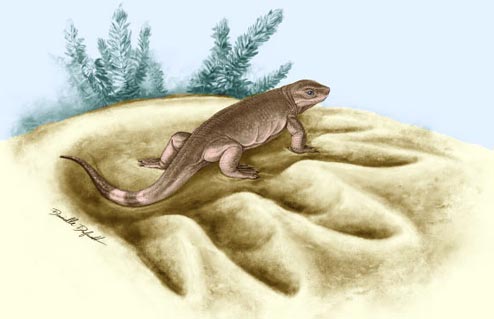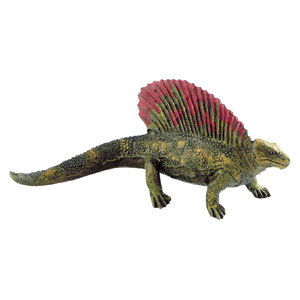Fossil Find Provides Information on the Evolution of Herbivores
Earliest Ancestor of Terrestrial Herbivores Discovered
When watching a wildlife documentary it is easy to overlook some fundamental truths about today’s complex ecosystems with their multi-layered food chains. Lions attacking zebras on the Serengeti, caribou grazing on Arctic lichens and mosses, foxes chasing after rabbits for instance. We have predators which prey on primary consumers of plant materials, the predator/prey relationship. However, such complex ecosystems have not been present throughout the history of land vertebrates, back in the days of the very first land animals with backbones ecosystems were populated by carnivores, it seems the ability to digest tough plant materials such as cellulose had to evolve and that herbivory has its roots amongst the meat-eaters.
Fossil Find
Newly published research into the fossil of a reptile discovered in Kansas, by scientists from the University of Toronto Mississauga in collaboration with researchers from Museum für Naturkunde and Humboldt-University (Berlin), had shed light on the evolutionary processes that led to the transition of carnivores into land herbivores. The specimen which consists of some cranial material from the back of the skull, the backbone, ribs, elements from the pelvic girdle and the right rear limb was collected by Dr Larry Martin, the curator of the Dyke Museum of Natural History, University of Kansas. Dr Martin was exploring a highly fossiliferous location known as Hamilton Quarry in south-eastern Kansas. Strata laid down at this site were formed in a tidal environment with changing sea levels.
A diverse variety of fauna and flora has been preserved including many fish species, some amphibians and a few, rare reptiles. The twenty centimetre long specimen was poorly preserved with those bones exposed in the matrix showing signs of erosion. To preserve the fossil and to allow it to be properly studied, the fossil was loaned to the Biology Department at the University of Toronto. It was encased in epoxy resin to stabilise it and to permit further cleaning and preparation. Unfortunately, the acidic solution used to clean the fossil and to reveal important anatomical details dissolved the fine, conical teeth that had been preserved in the jaw.
Photograph and Illustration of the Fossil Material (KUVP 9616b)
Picture credit: PLOS One/Reisz RR, Fröbisch J.
The skull material is located in the top right of the image, with the hind limb and the pelvic bones located top left. The fossil material is believed to represent a juvenile.
Eocasea martini
The little reptile has been named Eocasea martini. The genus name means “dawn or first Caseidae”, the clade of synapsids that this animal belonged to. The specific or trivial name honours Dr Larry Martin. Caseids are an ancient group of terrestrial vertebrates that form part of a larger group known as synapsids. Synapsids represent a diverse and unusual group of vertebrates, that include the ancestors of modern reptiles and all mammals, plus those reptiles that have closer affinities to Mammalia than they do to extant reptiles, the so-called mammal-like reptiles. The fearsome Dimetrodon is an example of a synapsid along with the tusked dicynodonts such as Placerias and the ancestors of today’s mammals.
An Illustration of Eocasea martini
Picture credit: Danielle Dufault
A “Ghost Lineage”
The fossil has been dated to around 300 million years ago, (Upper Pennsylvanian of the Carboniferous). The discovery helps to close a twenty million year gap between E. martini and the next oldest caseid known from the fossil record. When scientists map the evolution of closely related organisms and find large gaps in the known fossil material, leading back to a very early ancestral form, as in this case, it is referred to as a “ghost lineage”.
Commenting on the significance of the research, Professor Robert Reisz of the Department of Biology at the University of Toronto stated:
“The evolution of herbivory was revolutionary to life on land because it meant terrestrial vertebrates could directly access the vast resources provided by terrestrial plants. These herbivores in turn became a major food resource for large land predators.”
One of the authors of the paper published in the on line scientific journal PLOS One, Jörg Fröbisch (Museum für Naturkunde and Humboldt-University in Berlin), added:
“Eocasea is one of the oldest relatives of modern mammals and closes a gap of about twenty million years to the next youngest members of the caseid family. This shows that caseid synapsids were much more ancient than previously documented in the fossil record.”
Analysis of the fossil material indicates that Eocasea martini was a basal member of the caseids, a carnivore feeding on small animals and insects but fossils of caseids dating from the Permian provide clear evidence that terrestrial herbivores evolved from this group’s small, carnivorous members, animals such as Eocasea.
Evidence for Herbivory
The evolution of the ability to consume, process and digest tough plant material is regarded by many scientists as one of the most important developments in the evolution of land living animals with backbones. Adapting to a diet largely consisting of vegetation requires some modifications to the body plan of an animal, these adaptations can be observed by studying the fossil bones of long extinct creatures. For example, in order to cope with hard to digest cellulose, the digestive tract tends to get much bigger and a larger, wider body is required to support a bigger gut. A longer or broader trunk region can be seen in preserved fossils when their skeletons are compared to those of similar sized carnivores.
The body cavity becomes modified to house a bigger digestive tract, which in turn has to house a huge number of symbiotic bacteria to permit the fermentation and and breakdown of plant cells. Palaeontologists, can therefore identify Palaeozoic herbivores because their rib cages are typically much wider with a bigger capacity than closely related insectivores and carnivores.
The Wide Body of Edaphosaurus (Herbivorous Pelycosaur)
Picture credit: Everything Dinosaur
The image (above) shows a Bullyland Edaphosaurus figure. To view the range of Bullyland “Prehistoric World” figures including the Edaphosaurus (whilst stocks last): Bullyland “Prehistoric World” Models.
The researchers conclude that Eocasea is one of the first animals to have started the process that would result in the establishment of modern ecosystems, with many plant-eaters supporting fewer types of predator – the start of more complex food chains.
Intriguingly, the research team went onto identify that the ability to digest and process vegetation was not just established in the lineage that includes the caseids, it arose independently at least five times more, including twice in the Reptilia.
Professor Reisz added:
“When the ability to feed on plants occurred after Eocasea, it seems as though a threshold was passed. Multiple groups kept re-evolving the same herbivorous traits.”
The five groups developed the novel ability to live off plants in staggered bursts with synapsids such as Eocasea preceding reptiles by nearly 30 million years. This shows that herbivory as a feeding strategy evolved first amongst those synapsids that are the ancestors of the Mammalia. Our ancestors evolved a taste for plants long before that branch of the terrestrial vertebrates that includes extant reptiles, the dinosaurs and Aves (birds).
Moving onto a plant-eating diet, resulted in a dramatic change in the size of early herbivores over the duration of the Permian geological period. Four of the five groups showed that as the Permian progressed so herbivores got bigger and bigger. The age of the super-sized grazer had dawned. Professor Reisz observed that the caseids showed the most extreme examples of size increase. The earliest member of the group, the diminutive Eocasea martini probably weighed less than two kilogrammes when fully grown. Later caseids weighed more than two tonnes, one of the largest known being the enormous, fat bellied Cotylorhynchus whose fossils have been found in the United States.
The research team have stated that the study of Eocasea has led to more questions being asked then answers found. For example, why didn’t the ability to digest plant material evolve earlier on? Why did herbivory evolve independently in at least five lineages of vertebrates?
Perhaps there are fossils out there which will shed further light on these mysteries.




